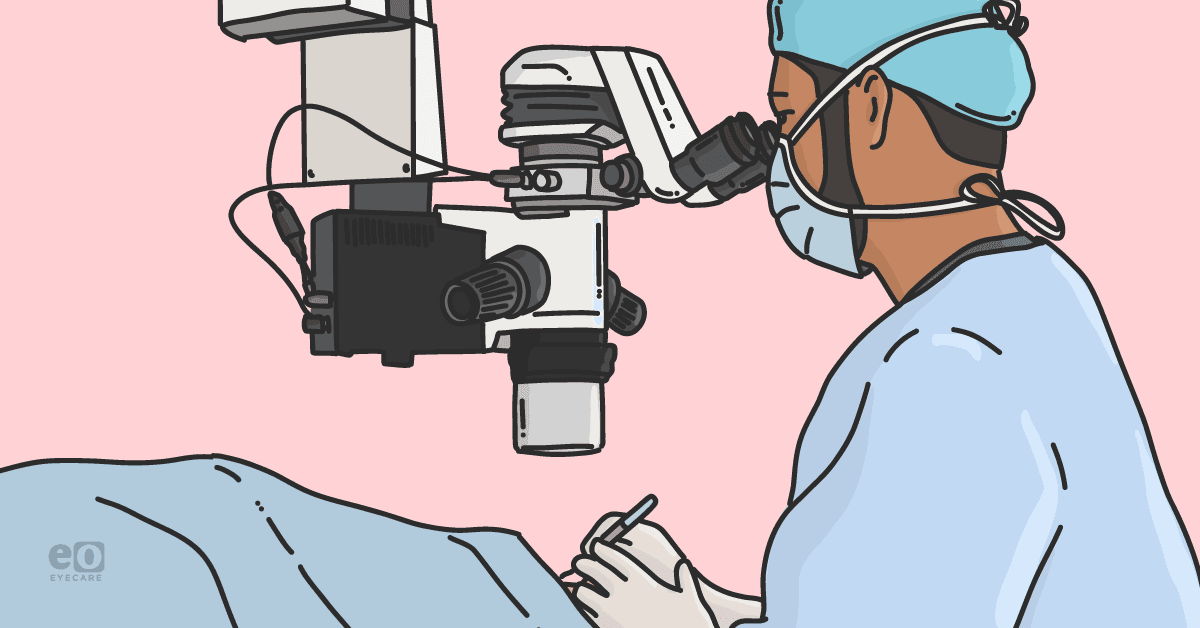A New Frontier: Descemet's Stripping Only/Without Endothelial Keratoplasty (DSO)/(DWEK)
Gain an overview of DSO/DWEK as an alternative to DSEK/DMEK for mild to moderate cases of corneal edema, including Fuchs’ endothelial corneal dystrophy.
- Hamill CE, Schmedt T, Jurkunas U. Fuchs endothelial cornea dystrophy: a review of the genetics behind disease development. Seminars in Ophthalmology. 2013;28(5-6):281–286. https://doi.org/10.3109/08820538.2013.825283
- Eghrari AO, Gottsch JD. Fuchs' corneal dystrophy. Expert Review of Ophthalmology. 2010;5(2):147–159. https://doi.org/10.1586/eop.10.8
- Vedana G, Villarreal G Jr, Jun AS. Fuchs endothelial corneal dystrophy: current perspectives. Clinical Ophthalmology (Auckland, N.Z.). 2016;10:321–330. https://doi.org/10.2147/OPTH.S83467
- Moshirfar M, Somani AN, Vaidyanathan U, et al. Fuchs Endothelial Dystrophy. StatPearls [Internet]. Treasure Island (FL): StatPearls Publishing. https://www.ncbi.nlm.nih.gov/books/NBK545248/. Updated August 1, 2022.
- Maier P, Reinhard T, Cursiefen C. (2013). Descemet stripping endothelial keratoplasty--rapid recovery of visual acuity. Deutsches Arzteblatt International. 2013;110(21):365–371. https://doi.org/10.3238/arztebl.2013.0365
- Trindade BLC, Eliazar GC. Descemet membrane endothelial keratoplasty (DMEK): an update on safety, efficacy and patient selection. Clin Ophthalmol. 2019;13:1549-1557. doi:10.2147/OPTH.S178473
- Price MO, Price FW. Descemet's stripping endothelial keratoplasty. Current Opinion in Ophthalmology, 2007;18(4):290–294. https://doi.org/10.1097/ICU.0b013e3281a4775b
- Chen SY, Terry MA. Step-by-step Descemet's membrane endothelial keratoplasty surgery. Taiwan Journal of Ophthalmology. 2019;9(1):18–26. https://doi.org/10.4103/tjo.tjo_108_18
- Borroni D, Rocha de Lossada C, Parekh M, et al. Tips, tricks, and guides in Descemet membrane endothelial keratoplasty learning curve. Journal of Ophthalmology. 2021;2021:1819454. https://doi.org/10.1155/2021/1819454
- Fernandez MM, Afshari NA. Endothelial Keratoplasty: From DLEK to DMEK. Middle East African Journal of Ophthalmology. 2010;17(1):5–8. https://doi.org/10.4103/0974-9233.61210
- Phillips PM, Phillips LJ, Muthappan V, et al. Experienced DSAEK Surgeon's Transition to DMEK: Outcomes Comparing the Last 100 DSAEK Surgeries With the First 100 DMEK Surgeries Exclusively Using Previously Published Techniques. Cornea. 2017;36(3):275–279. https://doi.org/10.1097/ICO.0000000000001069
- Deng SX, Lee WB, Hammersmith KM, et al. Descemet Membrane Endothelial Keratoplasty: Safety and Outcomes: A Report by the American Academy of Ophthalmology. Ophthalmology. 2018;125(2):295–310. https://doi.org/10.1016/j.ophtha.2017.08.015
- Marques RE, Guerra PS, Sousa DC, et al. DMEK versus DSAEK for Fuchs' endothelial dystrophy: A meta-analysis. European Journal of Ophthalmology. 2019;29(1):15–22. https://doi.org/10.1177/1120672118757431
- Miron A, Bruinsma M, Ham L, et al. In Vivo Endothelial Cell Density Decline in the Early Postoperative Phase After Descemet Membrane Endothelial Keratoplasty. Cornea. 2018;37(6):673–677. https://doi.org/10.1097/ICO.0000000000001484
- Baydoun L, Ham L, Borderie V, et al. Endothelial Survival After Descemet Membrane Endothelial Keratoplasty: Effect of Surgical Indication and Graft Adherence Status. JAMA Ophthalmology. 2015;133(11):1277–1285. https://doi.org/10.1001/jamaophthalmol.2015.3064
- Zafar S, Parker JS, de Kort C, et al. Perceived difficulties and barriers to uptake of Descemet's membrane endothelial keratoplasty among surgeons. Clinical Ophthalmology (Auckland, N.Z.). 2019;2019(13):1055–1061. https://doi.org/10.2147/OPTH.S212871
- Trindade BLC, Eliazar GC. Descemet membrane endothelial keratoplasty (DMEK): an update on safety, efficacy and patient selection. Clinical Ophthalmology (Auckland, N.Z.). 2019;2019(13):1549–1557. https://doi.org/10.2147/OPTH.S178473
- Maier AK, Gundlach E, Schroeter J, et al. Influence of the difficulty of graft unfolding and attachment on the outcome in Descemet membrane endothelial keratoplasty. Graefe's Archive for Clinical and Experimental Ophthalmology. 2015;253(6):895–900. https://doi.org/10.1007/s00417-015-2939-9
- Borkar DS, Veldman P, Colby KA. Treatment of Fuchs Endothelial Dystrophy by Descemet Stripping Without Endothelial Keratoplasty. Cornea. 2016;35(10):1267–1273. https://doi.org/10.1097/ICO.0000000000000915
- Braunstein RE, Airiani S, Chang MA, Odrich MG. Corneal edema resolution after "descemetorhexis". Journal of Cataract and Refractive Surgery. 2003;29(7): 1436–1439. https://doi.org/10.1016/s0886-3350(02)01984-3
- Blitzer AL, Colby KA. Update on the Surgical Management of Fuchs Endothelial Corneal Dystrophy. Ophthalmol Ther. 2020;9(4):757-765. doi:10.1007/s40123-020-00293-3
- Davies E, Jurkunas U, Pineda R. Predictive Factors for Corneal Clearance After Descemetorhexis Without Endothelial Keratoplasty. Cornea. 2018;37(2):137–140. https://doi.org/10.1097/ICO.0000000000001427
- Iovieno A, Neri A, Soldani AM, et al. Descemetorhexis Without Graft Placement for the Treatment of Fuchs Endothelial Dystrophy: Preliminary Results and Review of the Literature. Cornea. 2017;36(6):637–641. https://doi.org/10.1097/ICO.0000000000001202
- Vieira R, Castro C, Coelho J, et al. Descemet Stripping Without Endothelial Keratoplasty in Early-Stage Central Fuchs Endothelial Dystrophy: Long-term Results. Cornea. 2022;42(8):980-985. https://doi.org/10.1097/ICO.0000000000003131
- Price MO, Scanameo A, Feng MT, Price FW Jr. Descemet's Membrane Endothelial Keratoplasty: Risk of Immunologic Rejection Episodes after Discontinuing Topical Corticosteroids. Ophthalmology. 2016;123(6):1232–1236. https://doi.org/10.1016/j.ophtha.2016.02.001
- Huang MJ, Kane S, Dhaliwal DK. Descemetorhexis Without Endothelial Keratoplasty Versus DMEK for Treatment of Fuchs Endothelial Corneal Dystrophy. Cornea. 2018;37(12):1479–1483. https://doi.org/10.1097/ICO.0000000000001742
- Ong Tone S, Kocaba V, Böhm M, et al. Fuchs endothelial corneal dystrophy: The vicious cycle of Fuchs pathogenesis. Prog Retin Eye Res. 2021;80:100863. doi:10.1016/j.preteyeres.2020.100863
- Moloney G, Petsoglou C, Ball M, et al. Descemetorhexis Without Grafting for Fuchs Endothelial Dystrophy-Supplementation With Topical Ripasudil. Cornea. 2017;36(6):642–648. https://doi.org/10.1097/ICO.0000000000001209
- Garcerant D, Hirnschall N, Toalster N, et al. Descemet's stripping without endothelial keratoplasty. Current Opinion in Ophthalmology. 2019;30(4):275–285. https://doi.org/10.1097/ICU.0000000000000579
- Okumura N, Kinoshita S, Koizumi N. Application of Rho Kinase Inhibitors for the Treatment of Corneal Endothelial Diseases. Journal of Ophthalmology. 2017;2017:2646904. https://doi.org/10.1155/2017/2646904
Dr. Robin Kuriakose is a board-certified and fellowship-trained cornea, cataract, and refractive surgeon. He completed his residency training at Loma Linda University Health in southern California and his fellowship training in Cornea and Refractive Surgery at Northwestern University in Chicago, where he was named Fellow of the Year. Dr. Kuriakose is passionate about mentorship, technology, and innovation. He has developed mobile applications and websites to aid fellow ophthalmologists as well as patients. Dr. Kuriakose is a New York native, but now practices in the Bay Area in California where he enjoys teaching local ophthalmology residents and other eye care providers.
Reysha Patel is currently an MD candidate at the University of California Riverside School of Medicine. She completed her Bachelor of Science in bioengineering/bioinformatics at the University of California San Diego.
